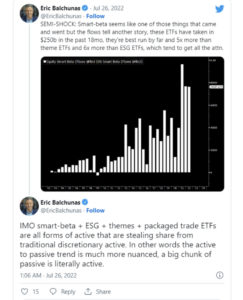Smart beta vs alpha – why one investing strategy is reaching new heights
Experts
Smart beta vs alpha – is an actively managed fund superior to passive management? It is a long running debate with active funds having to beat the average of their passive peers over a certain time frame to win the game.
Diversified low-cost index funds incorporating smart beta, also known as factor investing, such as ETFs have becoming increasingly popular and are a tough player to beat. Smart beta combines the worlds of active and passive management.
Passive management replicates a specific benchmark or index to match its performance for a low cost. Active management portfolios strive for superior returns using a team of analysts who determine which stocks to buy and which to sell, but they do this for larger fees.
Smart beta retains the low cost of passive management while targeting the outcomes of active management.
To find out more Stockhead caught up with VanEck Australia CEO and Managing Director Asia Pacific, Arian Neiron. He’s one of those guys who it might be worth jostling to sit next to at a dinner party and advance your knowledge of investing.
“We would define smart beta as any index strategy that is constructed differently from market capitalisation, which is the measure of the total market value of a company with market capitalisation indices constructed using this information and size being the eligibility for inclusion in the index,” Neiron said.
“Market capitalisation indices are the source of market performance reported in the media, for example the S&P/ASX 200 Index contains the 200 largest companies on ASX.”
He said most passive ETFs track market capitalisation indices.
“Smart beta ETFs track indices that take a ‘smarter’ and more considered approach to what goes into the fund other than just the size of the company,” he said.
“Some examples of smart beta would be factor-based, such as indices that screen for quality or value characteristics, or indices that use alternate weighting methodologies such as equal weighting or capping.
“We see smart beta as combining the best of active and passive investing having the potential for better investment outcomes while being rules-based, transparent and cost efficient.”

Neiron said actively managed funds aim to outperform the fund’s benchmark index, usually the relevant market capitalisation index.
“In financial jargon the performance of the benchmark is called beta so if the beta is 10%, the fund aims to return more than 10%,” he said.
“If the beta falls 10%, the fund’s goal is to fall less than 10% so to outperform, an active fund manager will buy stocks they think will perform better than the rest of the benchmark index and sell stocks that they think will perform worse than the rest of the benchmark index.
“In financial jargon, outperformance above the beta is called alpha.”
Beta is therefore the return of the market, while alpha is the returns above or below the index.
“Because smart beta indies are constructed differently they therefore perform differently to beta.”
Neiron said smart beta strategies are attractive compared to active management due to:
But Neiron said smart beta is not without its drawbacks.
“Like active managers there are well-designed, well-thought out smart beta strategies and there are some that are poorly designed, leaving investors with outcomes different to what they thought they would achieve,” he said.
Neiron said examples of bad design include starting with the wrong beta, using approaches that are not proven or thinking that what works in one market will work in another market.
Factor investing refers to investing based on systematic drivers of market returns. It can be applied across different asset classes. Examples include quality and value.
“While ‘factor’ investing may work in deep, large markets internationally, we have shown the efficacy of factors in the small Australian (market) is not strong,” he said.
Another disadvantage of factor investing, is that factors tend to be cyclical. He said some investors see this as an opportunity and try to pick cycles, shifting between factors, but like picking the top and the bottom of a market, this is very difficult.
“We would hazard that investors stay the course with strategies that demonstrate performance over a long period of time, that are backed by rigorous research.”
Neiron said performance is how all funds are measured but it is probably also important to assess the risk a manager takes too.
“Returns are often said to be the reward for risk, the higher the risk the higher potential returns,” he said.
Neiron said there are many ways fund managers may present their risk/reward.
“For us the Sharpe ratio, which combines a return measure with a volatility measure to quantify the relationship between the returns and risk is a useful tool,”he said.
“If your fund has a higher sharpe ratio than its index, it is providing better risk-adjusted returns.”
In terms of international factor smart beta ETFs there’s the VanEck MSCI International Value ETF (ASX:VLUE) and VanEck MSCI International Quality ETF (ASX:QUAL).
VanEck MSCI Multifactor Emerging Markets Equity ETF (ASX:EMKT) is an emerging market multiple-factor smart betas approach, while VanEck Vectors Morningstar World ex Australia Wide Moat ETF – GOAT (ASX:GOAT) and VanEck Morningstar Wide Moat ETF (ASX:MOAT) smart beta ETFs track Morningstar indices that include only the most attractively priced wide moat companies.
On the income front VanEck Morningstar Australian Moat Income ETF (ASX:DVDY) tracks a Morningstar index and is based on high dividends and Morningstar’s moat rating.
Neiron said in fact the first Smart Beta ETF of ASX was a dividend focused ETF, being the Vanguard High Yield ETF (ASX:VHY).
With Australian equities, VanEck Australian Equal Weight ETF (ASX:MVW) is popular as is the VanEck Small Companies Masters ETF (ASX:MVS).
The views, information, or opinions expressed in the interviews in this article are solely those of the interviewees and do not represent the views of Stockhead. Stockhead does not provide, endorse or otherwise assume responsibility for any financial product advice contained in this article.